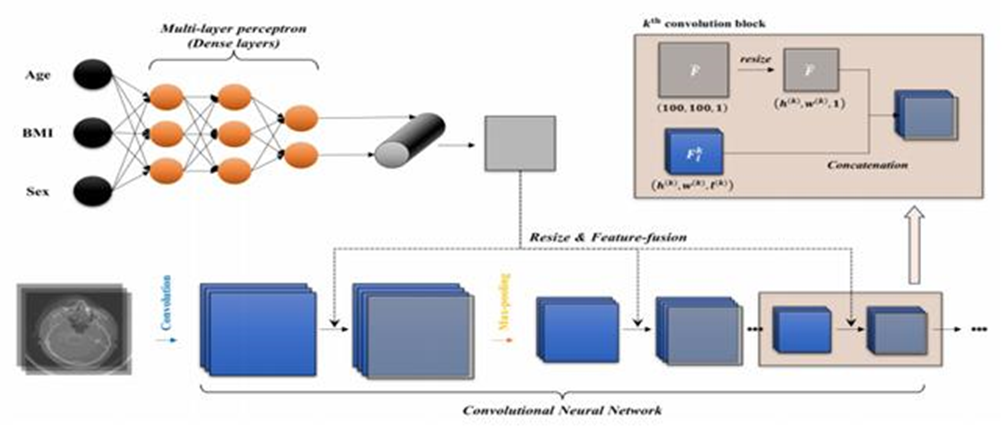Development of a technology, Predicting Obstructive Sleep Apnea Based on Computed Tomography (CT) Scans Using Deep Learning Models
- Seoul National University Hospital, Bundang Seoul National University Hospital, Dongguk University Ilsan Hospital, DGIST, Development of a deep learning model
- Combining 3D CT images and patient data, improving prediction accuracy with the airway-specific algorithm
- Faster and more cost-effective diagnostic method than conventional sleep polygraphy... Expected to improve patient's quality of life
A joint research team from Seoul National University Hospital, Bundang Seoul National University Hospital, Dongguk University Ilsan Hospital, and DGIST has developed a new method to diagnose and predict the severity of obstructive sleep apnea (OSA) by analyzing CT images using a deep learning model. This study is expected to establish a new standard for the diagnosis of OSA by presenting a faster and more cost-effective alternative to conventional polysomnography.
A joint research team consisting of Professor Kong Hyoun Joong of the Department of Transdisciplinary Medicine and Professor Kim Hyun Jik of the Department of Otorhinolaryngology, Seoul National University Hospital(SNUH), Professor Kim Jeong-Whun of the Department of Otorhinolaryngology, Seoul National University Bundang Hospital, Professors Park Seok-Won and Kim Jin Youp of the Department of Otorhinolaryngology, Dongguk University Ilsan Hospital, and Professor Hwang Jae Youn of the Department of Electrical, Electronic and Computer Engineering, DGIST (Professor Lee Kyungsu of Chonbuk National University) announced the results of a study that developed a method for diagnosing and predicting severity through CT image analysis based on a deep learning model targeting a total of 1,018 obstructive sleep apnea patients and verified its performance on the 4th of October.
Obstructive sleep apnea (OSA) is a disease in which the upper airway is repeatedly narrowed or blocked during sleep, making breathing difficult. Approximately 6-38% of the world's population suffers from this disease. It causes various complications such as cardiovascular disease, diabetes, and depression, and seriously reduces the quality of sleep. However, conventional polysomnography is expensive and medical accessibility is limited, so many patients do not receive proper diagnoses.
To solve these problems, the research team developed a deep learning model, AirwayNet-MM-H, to diagnose obstructive sleep apnea and predict its severity using previously captured craniofacial CT images including paranasal sinuses. This model significantly improved prediction accuracy by combining 3D CT images with the patient’s age, gender, and body mass index (BMI), and further improved performance by applying a preprocessing algorithm that emphasizes the airway area.

[Figure] AirwayNet-MM-H model structure: A model for diagnosing and predicting the severity of obstructive sleep apnea (OSA) that combines MLP, which processes structured data (age, gender, BMI), and CNN, which processes unstructured data (CT images).
The AirwayNet-MM-H model diagnoses obstructive sleep apnea and predicts the severity of diagnosed patients by combining a 3D convolutional neural network (3D CNN) that analyzes the 3D structure of CT images and a multilayer perceptron (MLP) that processes patient data. This model is used to classify into 4 grades (normal, mild, moderate, and severe) or as a 2-grade classification method (moderate or higher, mild/normal) that predicts moderate or higher obstructive sleep apnea.
In this study, the model was trained and its performance was verified based on 798 internal data and 135 and 85 external data sets.
As a result, the AirwayNet-MM-H model recorded a prediction accuracy of 87.6% in the 4-class classification with internal data and showed high accuracy of 84.0% and 86.3% in the external data set, respectively.
In particular, the 2-class classification predicting moderate to severe obstructive sleep apnea recorded a prediction accuracy of 91.0% in the internal data and showed high prediction accuracy in the external data set.
In addition, the diagnostic performance of the AirwayNet-MM-H model was compared with existing deep learning models, and the accuracy was up to 14.2% higher than the existing model in the internal data set, and the AUROC value was 0.152 better. The accuracy was also 11.9% higher in the external data set, and the AUROC value was 0.111 higher, showing better performance than the other six latest deep learning models.
The research team expects that this deep learning model will be useful in clinical practice as it can be used for risk assessment before and after surgery. They also emphasized that it is cost-effective as it can diagnose using CT data that has already been taken without additional tests or costs.
Professor Kong Hyoun Joong of the Department of Transdisciplinary Medicine said, “This deep learning model can provide rapid and accurate diagnosis to patients who have difficulty accessing conventional polysomnography, and is expected to greatly improve the quality of life of patients through early diagnosis and treatment.” He added, “We plan to verify and improve the performance through more external data in the future, and evaluate the applicability to various races and patient groups.”
The results of this study were published in the latest issue of the ‘American Journal of Respiratory and Critical Care Medicine (IF 19.3)’.

[Photo from left] Professor Kong Hyoun Joong from SNUH, Professor Kim Jeong-Whun from SNUBH, Professor Kim Hyun Jik from SNUH, Professors Park Seok-Won and Kim Jin Youp from Dongguk University Ilsan Hospital, Professor Hwang Jae Youn from DGIST and Professor Lee Kyungsu from Chonbuk National University